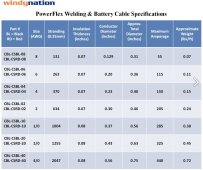elizabethii
New Member
- Joined
- Jun 3, 2022
- Messages
- 25
When I built out my system, I included a Class-T fuse holder inline with the main cable coming off the battery rack bus bar. I'm using 4/0 105C-rated welding cable from the battery bank bus bars to the main distribution bus bars. The total run one-way from the distribution bars to the battery bank bus is less than 5 feet. I installed a 400amp fuse in the holder, and I swear I had some logic behind the sizing at the time, but I don't remember what it was and now I'm really doubting myself.
I'm running 2 currently-installed 3000EHV-48 inverters and will likely install 2 additional future 3000EHV-48 inverters once I expand the scope of the system. At full load, the 4 inverters shouldn't be able to pull much more than 250 amps, which itself makes me wonder if I have heavy enough cable. I recently saw a chart that claimed 4/0 was only good for 200 amps, but also found a different one that it was good for 600 amps for less than 50 feet of total run. I think the discrepancy is related to assumptions based on system voltage and AC/DC, but I never learned the theory behind how to calculate ampacity. I just have amp ratings for the common wire sizes in 120/240 VAC and 12VDC memorized...
Should I adjust my fuse size and/or wire gauge for my system?
I'm running 2 currently-installed 3000EHV-48 inverters and will likely install 2 additional future 3000EHV-48 inverters once I expand the scope of the system. At full load, the 4 inverters shouldn't be able to pull much more than 250 amps, which itself makes me wonder if I have heavy enough cable. I recently saw a chart that claimed 4/0 was only good for 200 amps, but also found a different one that it was good for 600 amps for less than 50 feet of total run. I think the discrepancy is related to assumptions based on system voltage and AC/DC, but I never learned the theory behind how to calculate ampacity. I just have amp ratings for the common wire sizes in 120/240 VAC and 12VDC memorized...
Should I adjust my fuse size and/or wire gauge for my system?



